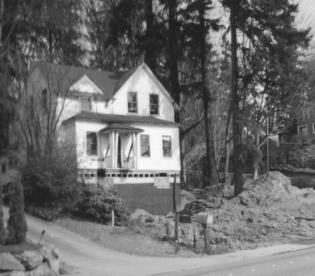3. Historical Context
The Lakeview neighborhood is part of what was once the City of Houghton until 1968 when Houghton merged with Kirkland. As a result of the merger, the Houghton Community Council retained jurisdiction over land use decisions within the neighborhood.
Notable Houghton settlers were the Samuel French, the Jay O’Conner, the Curtis, the Fish and the Lute Marsh families. What is now known as the Orton House (Sutthoff House) at 4120 Lake Washington Boulevard was originally built in 1903 by realtor Charles Parrish for the Morris Orton family. The Orton house was then rented to a Dr. George Hudson Davis around 1910 and used as the area’s first hospital and dental office. The Herman Schuster house (grandfather of Louis Marsh) was built just north of the Orton home. The French house was moved from its original location at 10126 NE 63rd Street to its present location at 4130 Lake Washington Boulevard in 1978.

The French House was moved from 10129 NE 63rd Street to 4130 Lake Washington Boulevard in 1978.

Curtis Landing dock and the Houghton Post Office location.
In 1929, Louis Marsh built the Marsh Mansion on the property (6610 Lake Washington Boulevard) his parents purchased in 1905. Marsh Park, donated by Mr. Marsh, is on the land he acquired when Lake Washington was lowered in 1916. Harry French and other Houghton residents commuted to Seattle to work in Yesler’s Mill either by rowing boats, by horse or by daily ferry service. Harry French built a frame cabin for his family which later became Pleasant Bay’s (original name for Houghton) first classroom and its first Sunday school.
On Lake Washington Boulevard between NE 59th and 60th Streets, two older buildings exist that have been used as an antique store and offices. One was built in the 1900s and was the early site of the Houghton Post Office.
Where Carillon Point is today was the original location of the Lake Washington Shipyard, started in 1905 by two brothers-in-law – Bartsch and Tompkins. The shipyard was an employment hub, building wood ships during the First World War, then steel ships during the Second World War.
Near this location, NE 52nd Street (Curtis Road) was the first street in Houghton connecting Lake Washington Boulevard to 108th Avenue NE (Cort Road). After the shipyards closed in the late 1940s, the site was used for many years as a practice facility for the Seattle Seahawks football team.
The Lakeview Terrace neighborhood south of NE 68th Street and Lakeview Drive was built in 1942 to serve as housing for the Lake Washington Shipyard workers during the Second World War and many of the existing homes remain today. Terrace Park was originally the site for a community center for the Lakeview neighborhood during the war. Around 1955, the buildings were converted to house the Houghton City Hall, library, fire station and police station.

Lake Washington Shipyards during WWI and WWII.
For more detail on the history of Houghton see the Central Houghton Neighborhood Plan and the Community Character Chapter for goals and policies regarding the preservation and designation of historic buildings, structures, sites and objects of historical significance.
Goal L-1: Encourage preservation of structures, sites and objects of historical significance in the Lakeview Neighborhood.
Policy L-1.1: Encourage property owners to preserve buildings, structures, sites and objects of historical significance.
The Community Character Element list of Historic Buildings, Structures, Sites and Objects includes the structures and sites in the Lakeview Neighborhood: the Marsh Mansion at 6610 Lake Washington Boulevard, the French House at 4130 Lake Washington Boulevard, and the Orton House at 4120 Lake Washington Boulevard, the Shumway site at 510-528 Lake Street S. (structure was moved to Juanita), Lake Washington Shipyards site at Carillon Point and the Lake House site at 10127 NE 59th Street. The Marsh Mansion is recognized on the National and State Registers of Historic Places and contains a Historic Landmark zoning designation.
Notwithstanding the language regarding historic structures in the Goals and Policies Section of this Comprehensive Plan, it is the intent of the Houghton Community Council and the Kirkland City Council that only residential use should be permitted in either the Orton or French houses at their present site. The Marsh Mansion is the only historic structure which should be considered as possibly appropriate for nonresidential use.
Policy L-1.2: Provide directional signs, markers and interpretive information at structures, buildings, sites or objects of historical significance.
Individual historic properties are encouraged to add historic plaques and interpretive signs. Additional directional signs and interpretive centers at or near structures, buildings, sites or objects of historical significance around the neighborhood would help bridge Houghton’s rich history with future generations. Most of the original historic street names have been changed over the years. As street signs are replaced, the original street names could be added to recognize the neighborhood’s history. The Community Character Element of this Comprehensive Plan lists other techniques to preserve the neighborhood’s history.


